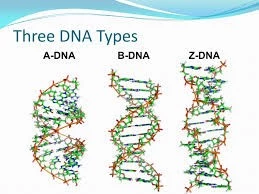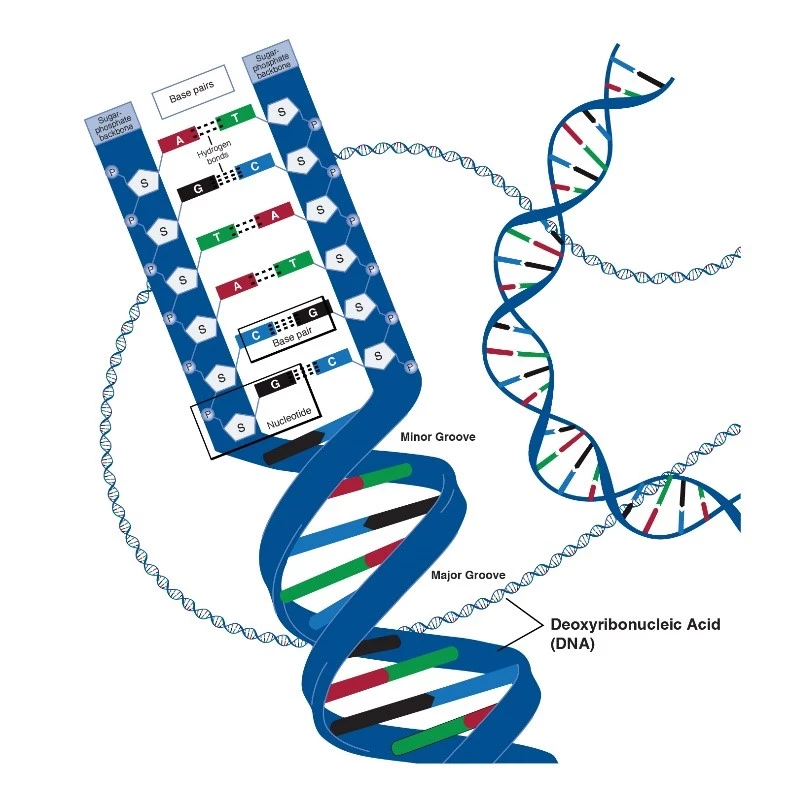Dna
DNA
What is DNA?
DNA stands for Deoxyribonucleic Acid and DNA is the molecule which is located within the nucleus of the cell, and its main job is to preserve and code the genetic information of the body. For most of the life cycle of the cell, the DNA is situated in the cell nucleus like a coiled noodle. But at some stage, while the cell replicates, the DNA is organised in the form of structure, namely chromosomes. The chromosomes help in preserving the stable DNA in the course of the time of the cellular replication. Now, most of you are familiar with the double helix model of the DNA.
The double helix version demonstrates that DNA is a polymer. To understand DNA, you have to review the definition of a polymer. The polymer is a molecule made up of several identical repeating units, and each unit is referred to as monomers.
If we take the example of a simple polymer known as a Starch, in this case, the repeating monomeric units are referred to as glucose. These glucose molecules are joined collectively by glucosidic bonds and form the polymer starch. Similarly, DNA is a polymer; here, the monomeric units are nucleotides.
Nucleotides

The above diagram shows the primary structure of a nucleotide. You can see that it includes three essential combinations: phosphate, the sugar, and the nitrogenous base. The sugar within the nucleotide is referred to as the deoxyribose that is a five-carbon sugar which belongs to the phosphate group onto which four oxygen atoms are attached. The third part of a nucleotide is the nitrogenous bases.
Definition Of DNA
“DNA is a set of molecules that is liable for carrying and transmitting the hereditary substances or the genetic codes from parents to offsprings.”
Abbreviation of DNA
DNA is called Deoxyribonucleic Acid. It is a natural compound that has a unique molecular shape.
Types of DNA
B-DNA: It is often the foremost common DNA conformation and maybe a right-handed helix. Majority of DNA shows a B kind conformation under normal physiological conditions.
Z-DNA: Z-DNA can be a left-handed DNA where the helix winds to the left in the course of a zig-zag pattern. Andres Wang and Alexander Rich had observed it. It is discovered earlier than the beginning site of a gene and consequently is assumed to play a few roles inside the gene regulation.
A-DNA: It is a right-handed helix, almost just like the B-DNA form. Dehydrated DNA constitute an A form that protects the DNA at some stage in an extreme situation like desiccation. Protein binding also eliminates the solvent from DNA, and consequently, the DNA takes an A shape.

If you look at the picture above, there are three double-stranded helices. The two strands wrap around each other in a spiral fashion . The wrapping has some distinctions, now can you tell which shape from the above picture is the exact shape of the DNA, the second one is more appropriate than the first one due to the fact that the wrapping of those strands collectively supply us sorts of grooves. Few grooves are broader that are known as major grooves. Some grooves are thinner and narrower and are known as minor grooves.
Related Videos:
DNA Structure
The DNA structure is often thought of a sort of a twisted ladder. This structure is described as a double-helix. It’s a macromolecule, and each nucleic acids is made up of nucleotides. The DNA molecule includes substances called nucleotides. Each nucleotide includes three different components, like sugar, phosphate corporations, and nitrogen bases.

The simple constructing blocks of DNA are nucleotides, which can be made up of a carbon-sugar group, a nitrogen base and a phosphate group. The sugar and phosphate groups link the nucleotides collectively to make every DNA strand Adenine (A), Thymine (T), Guanine (G) and Cytosine (C) are four kinds of nitrogen bases.
These 4 nitrogenous bases pair collectively in the following manner: A with T, and C with G. These base pairs are crucial for the DNA’s helix structure, which resembles a twisted ladder.
Chargaff’s Rule
A=T; C=G
The biochemist Erwin Chargaff found that the number of nitrogenous bases within the DNA was available in equal quantities. The quantity of A is equal to T, whereas the quantity of C is identical to G.
DNA Replication
DNA replication is a vital technique that occurs for the duration of cellular division. It is also known as semi-conservative replication, for the duration of which DNA duplicates itself.
DNA replication takes place in 3 stages :
Step 1: Initiation
Step 2: Elongation
Step 3: Termination
What are the functions of DNA?
The function of DNA include:
• Replication
• Gene expression
• Mutation
• Transcription
• Translation
Important Chapters:

B-DNA: It is often the foremost common DNA conformation and maybe a right-handed helix. Majority of DNA shows a B kind conformation under normal physiological conditions.
Z-DNA: Z-DNA can be a left-handed DNA where the helix winds to the left in the course of a zig-zag pattern. Andres Wang and Alexander Rich had observed it. It is discovered earlier than the beginning site of a gene and consequently is assumed to play a few roles inside the gene regulation.
A-DNA: It is a right-handed helix, almost just like the B-DNA form. Dehydrated DNA constitute an A form that protects the DNA at some stage in an extreme situation like desiccation. Protein binding also eliminates the solvent from DNA, and consequently, the DNA takes an A shape.


The simple constructing blocks of DNA are nucleotides, which can be made up of a carbon-sugar group, a nitrogen base and a phosphate group. The sugar and phosphate groups link the nucleotides collectively to make every DNA strand Adenine (A), Thymine (T), Guanine (G) and Cytosine (C) are four kinds of nitrogen bases.
These 4 nitrogenous bases pair collectively in the following manner: A with T, and C with G. These base pairs are crucial for the DNA’s helix structure, which resembles a twisted ladder.
DNA replication takes place in 3 stages :
Step 2: Elongation
Step 3: Termination
• Replication
• Gene expression
• Mutation
• Transcription
• Translation
